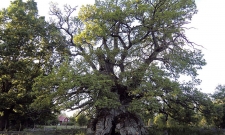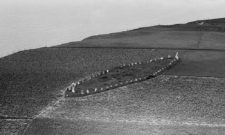
Apr
According to legend, the vertical cliffs of Halleberg in Västergötland are the site of an ättestupa, Sweden's highest, where Goths in ancient times are said to have "hoisted sails to Oden's Island" when they wanted to leave life on earth behind them.
The Halleberg hive, also called Hälleklint, is located on the southwest corner of the Halleberg which goes by the name Häcklan. To the west in the same corner you will also find the beautiful viewpoint Häckle cliff.
Halleberg is a mighty plateau mountain in the parish of Västra Tunhem in Väne härad, Västergötland, which juts out into Lake Vänern. The mountain is surrounded by many ancient monuments in the form of burial grounds, stones and cairns. In fact, the entire mountain is an ancient monument in the form of Sweden's largest ancient castle (more on that to come), almost entirely naturally fortified by the mountain's steep slopes.
On the crest of the hill at the top of the hill are the so-called "death benches", blocks of stone where, according to legend, the ancients sat and gathered courage before finally throwing themselves off the edge of the hill. Directly below the manor house there is a large Iron Age burial ground and the Domarringen Hästevads stones, which can be seen in the southwest next to the railway.
In Svenska Familj-Journalen, volume 12, issue 1873, Claës Joh. Ljungström about Ättestupan and "Hästevads Stenar" at Halleberg:
The hereditary stock in question, called "Hälleklint", is close nittio cubits high from the rock face below to the top edge. The rock itself, in which the formerly descending giants must have been crushed against the sharp and angular stones, has a vertical height of about twenty cubits.
Below the mound is in a straight line between it and the mounds a small oval pond forty cubits long and twenty cubits wide, bearing the name Oden dam and that almost never dries out. It is said that the corpses of those who sought Wallhall were washed here.
Several other sources mention this "pond of Odin", which was located directly below the giant's temple, and was supposedly used to wash the bodies of the dead Goths. Unfortunately, the pond was filled in again when a villa was built on the site in the 1920s, and is now patiently waiting for some future generation to dig up the sacred water again. You can read more about the pond in article about Hästevads stones.

Carl Linnaeus writes about the ättestupan in 1746 in Västgötaresan:
The Eat-storm is a Valhalla on the southernmost side of Häcklan, where the vertical, grooved grey and high side of the mountain far exceeds the slopes of the other Halls and Häclas; here the old Goths are said to have roared down and hoisted sail for Odin's island without thinking of the return journey, when all things would no longer go their way or when they had grown weary of the world and life itself.
F. E. Lindskog writes 70 years later, in 1816, on p. 165 of Attempt at a Short Description of Skara Diocese:
Here also our ancestors, the old Goths, had a hive of food, where they plunged out, and hoisted sail to the Isle of Odin, without thinking of the return voyage. Above, the mountain is smooth, and is called Wåhlehall or Wallhall; below is a pond, which is overgrown with moss, which Allmugen calls Onskälla or Oden's pond.

There is even a poem written in 1815 about this very ethnic group, by a Erik Sjöberg (known under the pseudonym Vitalis). The poems are called On the hermitage at Halleberg and goes like this:
Here stood the man in days gone by
With contempt for life and its Hardness,
And, despite the laws of nature,
Daringly hung to another world.Time has stretched its giant arm around the North:
The power, aged, is thinning on its mountains;
And soon there'll be a divorce not on earth
Between the man of the North and the dwarf of the South.High fathers! on your graves
Hear the oath, as a descendant swears:
In the past your Manheim was trampled by slaves,
I will die as you are worthy.And when shackles other shoulders press,
Their iron shall bounce from my arm.
Freedom! Freedom! man's first happiness!
You I shall possess at the bosom of the grave.When a descendant walks in the mountains,
From whose bow the rock resounds,
Should he blush at a glance at the stove,
Who reminds the weak of you.And perhaps, fathers, your memory
Rise up around the edge of a grave,
And give strength to his deaf mind
To throw off the slave's shackle.
The poem is a memory of the author's visit to the site on 15 July 1815. Shortly afterwards, Sjöberg wrote in a letter to a C. O. Berglund:
I passed Hallenberg, the highest I have seen in my lifetime. Our ancestors had found the place worthy of their last journey; in a word, there had been a hive of activity. The cliff rose vertically into the clouds, here and there hung a protruding stone half loosened, and on them I climbed. Out on the edge were planes like the ice on a lake in January: I went out as far as my courage would allow, that is, quite far, though not quite as far as our ancestors who went to Valhalla. But, O heavens, what a tremor came over my body as I went down. Now I know what it means, that the heart is in the posterior. When I took a step, the crumbling stones rolled from my trembling legs, and I then hung on my arms between heaven and earth, till my feet had sought another equally frail foothold. Finally, however, I came down from the burning furnace as whole as the Three Men (Shadrach, Meshach and Abednego) in the Old Testament. (Collected Writings, by Vitalis, Erik Sjöberg, Stockholm 1873, p. 416)
Halleberg's hive is well worth a visit, and should be combined with a visit to the Hästevads stones, which are a few steps southwest below the cliff. If not for the sake of legend and history, the visit can easily be justified by the beautiful view alone, described as "breathtaking" by Claës Joh. Ljungström in 1873:
The view already from the mounds, but even more from the cliff of the mound, preferably to the southwest beyond the properties of Kartened and Sandgärdet, partly towards Nygård along the slopes of Hunneberg, partly across the plain towards Rånnum and Göta elf and Trollhättan, on whose western side
forest-covered mountain ridges, is enchanting to those who have a mind open to the beauty of creation.
Getting there
You can park a few hundred metres after the building in the driveway to Halleberg. Then walk up the "bommade" road to a round water reservoir and keep left to get to the Ättestupan (orange markings). It is a walk of about 500m.
Coordinates: Latitude 58.35366338246362 | Longitude 12.418853044509888
Discover more interesting places to visit at History map.
Subscribe to YouTube:
If you appreciate Allmogens independent work to portray our fine Swedish history and Nordic culture, you are welcome to buy something nice in the shop or support us with a voluntary donation. Thank you in advance!
Support Allmogens via Swish: 123 258 97 29
Support Allmogens by becoming a member
Support Allmogens in your will
Historical maps of Västergötland
Our wall maps are carefully restored, centuries-old maps that are reprinted in Ångermanland on matte, age-resistant, museum-quality premium paper. 1% of the proceeds go directly back to cultural heritage!








